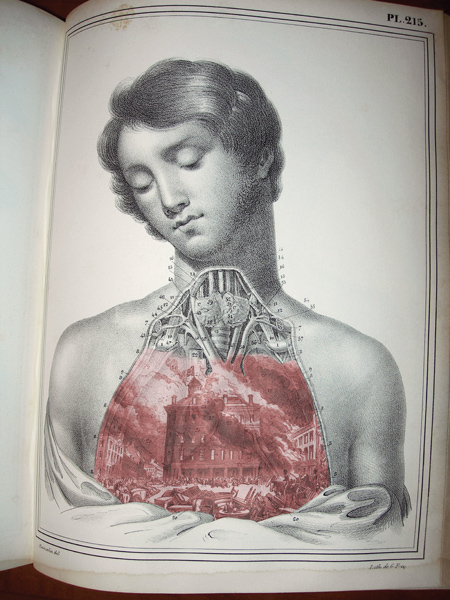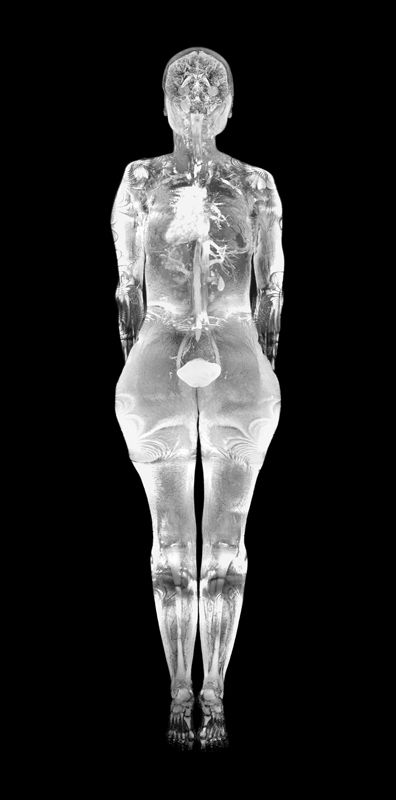[Fall 2009]
In Plain Sight Gallery, Montreal
April 18 to May 23, 2009
The Rx exhibition, curated by Penny Cousineau-Levine and Zoe Casino at the In Plain Sight Gallery in Montreal, explores the inherent conflicts aroused by the intrusions of medical devices and representations into the construction of identity. The presupposed neutrality and innocence of the medical gaze attempting to build up the utopian project of an exhaustive mapping of the human body (as in the case of the Visible Human Project in the 1990s) is painstakingly questioned, revealing instead the levels of control, submission, and trauma undergone by a patient in order for internal medical “coherence” to be restored. But such coherence is a myth. The body has long ceased to be understood as unified; rather, it is seen as having levels of fragmentation.
The photographic works of Chantal Gervais, Cindy Stelmackowich, and Sarah Sudhoff investigate the body subjected to invasive technological examinations and being penetrated by the medical gaze directed at what is not normally displayed in “plain sight.” Acknowledgment of the medical gaze reconfigures the system of knowledge, marking the transition of the body from the private to the public space.
The body, scanned and examined by a system that provides photographic proof, undergoes a fundamental internal dissociation. Chantal Gervais’s photographs exploit the flatbed scan device, as in her feminine Vitruvian self-portrait, and the MRI (magnetic resonance imaging), a medical technique used mainly in radiology. Meant to provide evidence of malfunctions within the patient’s body, the intrusive yet medically necessarily gaze on the unwanted and dysfunctional has become, in these photographs, a cartographer of the unseen geography of the body, creating an internal space to be explored. This procedure is turned, by a healthy artist, into a means of entering her own intimacy. The threshold of the skin has been crossed, even though there is no disease other than the construction of identity, there is no pain involved, no foreign body or abnormality. Interest itself is the intruder. Gervais’s stylized and almost transparently spectral self-portraits could be seen as the foreign body par excellence: present yet elusive, a permanent yet veiled threat, always a potential danger to be uncovered – the stranger within.
While Gervais performs an aesthetic inquiry into the internal structure of bodily fluids and organs, Cindy Stelmackowich places at the core of medical investigation, through the use of classic anatomical models in motionless postures, the experience of trauma and the repressed silence. In Stelmackowich’s images, the authority of the medical gaze, claiming knowledge of and control over the patient’s body, is confronted with representations of disasters. She juxtaposes lithographs from the nineteenth-century atlases used by surgeons with images of fires and shipwrecks taken from the London Illustrated News. The images of disasters find a “homely” dwelling in the representational crevasses opened up in the illustrated bodies, involving graphic details of veins, bones, and nerves, thus questioning the way in which the medically scrutinized patient experiences trauma.
Sarah Sudhoff’s intimate knowledge of cervical cancer triggers a step forward into the conflicted feelings of a patient facing a necessary medical intrusion that must also become a form of public scrutiny. The artist’s self-portrait within the aseptic environment of the hospital reveals a tensed body subjected not only to the inquiring gaze of her doctors, but also, within the space of the exhibition, to the look of total strangers, who witness a highly intimate hypostasis behind which lurks the raw presence of the actual cervical cancer. This striking presence determines her confrontation with a disease the cure for which requires a radical invasion of her body – a body now centred around a foreign presence, producing an emotional fragmentation. Disease and suffering relocate the body at the core of the impaired organs, creating an awareness that the previous muteness of the internal structure has been transformed into an explicit surfacing, therefore stripped of intimacy. And the more so, if we consider the artist’s representations of the ill body within the medical environment, a space designed to survey and exhibit what is unseen.
Through scanning, professional investigation, and documentation, medical and photographic gazes build representations of the body that penetrate its internal space, acknowledging the fundamental fragmentation already residing within. No matter how close this internal surveillance, the body preserves its fundamental estrangement, as Rx powerfully testifies.
Corina Ilea is a Ph.D. student at Concordia University, Montreal. Her research focuses on dis- placements of the body in contemporary photography.



